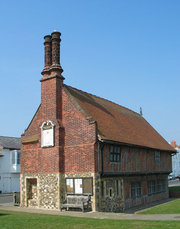Aldeburgh
|
|
Template:GBmap Aldeburgh is a town in Suffolk, East Anglia, England.
In the 16th century, it was a leading port and had a flourishing ship-building industry. Sir Francis Drake's ships Greyhound and Pelican (later renamed Golden Hind) were both built in Aldeburgh. When the River Alde silted up and was unable to accommodate larger ships, the area went into decline. Aldeburgh survived principally as a fishing village until the nineteenth century, when it became popular as a seaside resort. Much of its distinctive and whimsical architecture derives from this period. The river is now home to a flourishing yacht club.The Aldeburgh Moot Hall is a timber-framed building which has been used for council meetings for over 400 years. It also houses the local museum.
Outside the town, the Maltings at Snape is the venue for a well-known classical music festival every June. The Aldeburgh Festival was founded in 1948 by Benjamin Britten, Eric Crozier and Peter Pears. Britten died in Aldeburgh in 1976 and Pears in 1986.
Aldeburgh is also famous for its Fish and Chip shop. Owned and run by the Cooney family since the 1970s, it has been described in The Times as "Possibly the finest on the East Coast".
The town of Aldeburgh or 'Owlbarrow' is the setting of a series of children's illustrated books centered around Orlando (The Marmalade Cat) written by Kathleen Hale who spent holidays in the town. Many of the illustrations in the books feature landmarks in the town, most notably the Moot Hall.
Just north of Aldeburgh is the Sizewell nuclear power station.
Aldeburgh is a member of the European network Cultural Village of Europe.
Geography
Aldeburgh is located at 52° North, 1° East 1.

